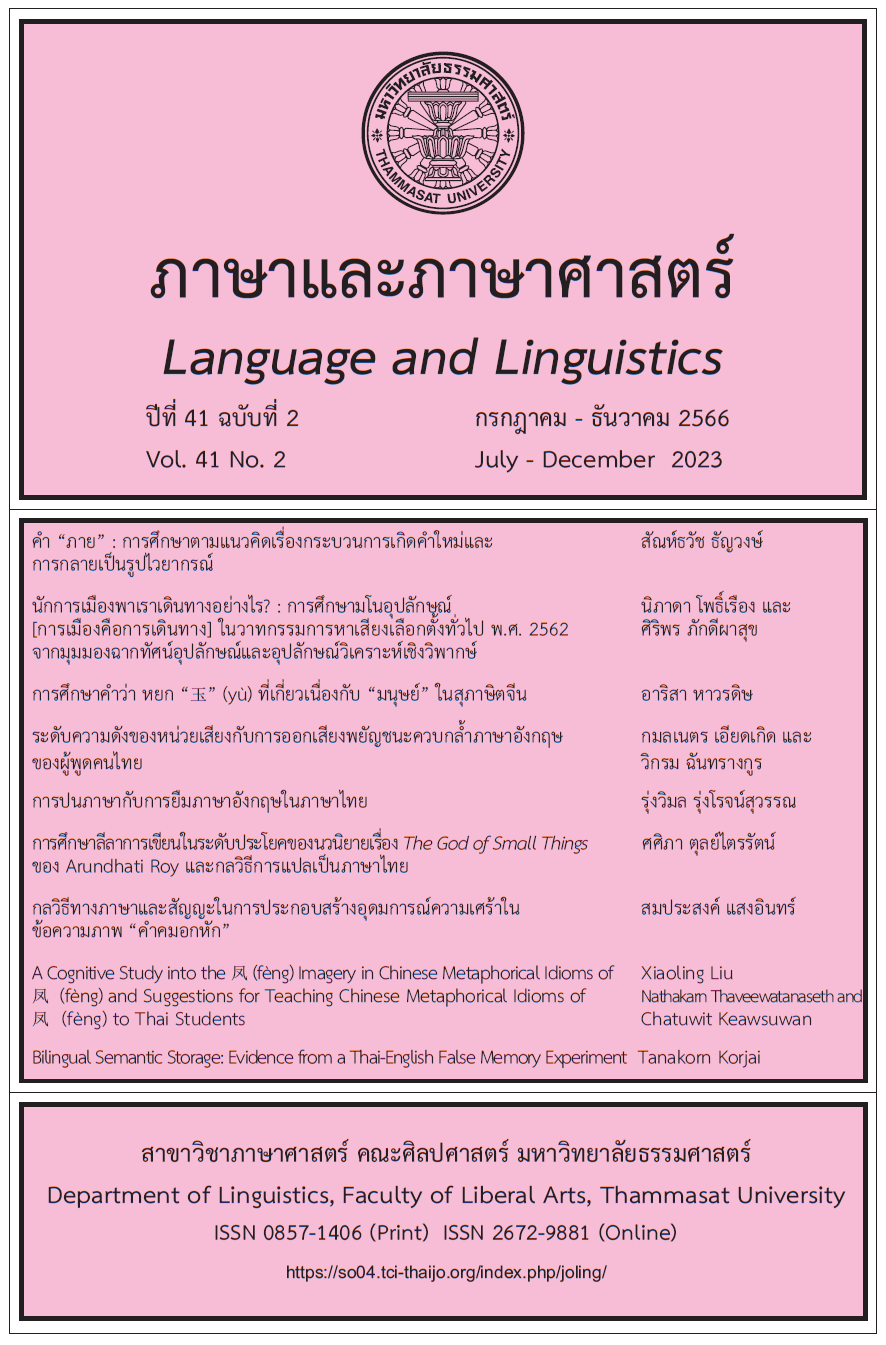Code Mixing and Linguistic Borrowing of English in Thai
Main Article Content
Abstract
In previous research on code-mixing and borrowing of English in the first language, there has been a debate on whether to differentiate between code-mixing and borrowing. However, no previous research on language mixing and borrowing of English in Thai has looked at the criteria for separating code-mixing and borrowing of English in Thai. Therefore, this research aimed to analyze the criteria for the analysis of English code-mixing words and borrowed words in the Thai language. The data were 400 English code-mixing words or borrowed words collected from 10 Thai magazines and newspapers published between the years 2019-2020. The findings showed that the criteria for the analysis of English code-mixing words can be ordered as follows: multiples written forms > English form usage > phonological integration. In addition, the criteria for the analysis of English borrowed words can be ordered as follows: phonological integration > Thai equivalents > morphological integration > syntactic integration > frequency of occurrence > existence in dictionary > semantic change, respectively. Lastly, the results showed that English words in Thai can be classified into 3 groups. The first group is a code-mixing stage. These represent words with 1-3 characteristics of code-mixing and 1-2 characteristics of borrowing. The second group is a code mixing and lexical borrowing stage. These represent words with 1-3 characteristics of code-mixing and 2-7 characteristics of borrowing. The final stage is the lexical borrowing stage. These are words with 1 characteristic of code-mixing and 3-6 characteristics of borrowing.
Article Details

This work is licensed under a Creative Commons Attribution-NonCommercial-NoDerivatives 4.0 International License.
บทความทุกบทความเป็นลิขสิทธิ์ของภาษาและภาษาศาสตร์
References
ฉันทณี รักธรรมยิ่ง. (2538). การใช้ภาษาแพทย์: การปนภาษาระหว่างภาษาไทยและภาษาอังกฤษ [วิทยานิพนธ์ปริญญามหาบัณฑิต]. มหาวิทยาลัยธรรมศาสตร์.
นภารัฐ ฐิติวัฒนา. (2539). การปนภาษาอังกฤษในภาษาไทยของอาจารย์ต่างสาขาวิชาในมหาวิทยาลัยเกษตรศาสตร์ [วิทยานิพนธ์ปริญญามหาบัณฑิต]. จุฬาลงกรณ์มหาวิทยาลัย.
นัฐยา บุญกองแสน. (2542). การปนภาษาอังกฤษในภาษาไทยกับทัศนคติทางภาษาของบุคคลต่างชั้นอาชีพ [วิทยานิพนธ์ปริญญามหาบัณฑิต]. จุฬาลงกรณ์มหาวิทยาลัย.
นิตยสาร ทีวีพูล - Tvpool. (29 กันยายน 2563). #ทีวีพูลปกใหม่ พิ้งกี้ สาวิกา ไชยเดช จากซีรีย์คลับฟรายเดย์ ตอน รักซับซ้อน. [Image attached] [Status update]. Facebook. https://www.facebook.com/photo/?fbid=2647699732145869&set=a.1498717393710781&locale=th_TH
นิตยา นิราศรพ. (2530). คำยืมภาษาอังกฤษในภาษาไทยระหว่าง พ.ศ. 2417-2453 [วิทยานิพนธ์ปริญญามหาบัณฑิต]. มหาวิทยาลัยธรรมศาสตร์.
ประยูร ทรงศิลป์ (2526). การเปลี่ยนแปลงของภาษา: คำยืมในภาษาไทย. เอกสารประกอบการเรียนรายวิชา ภาษาต่างประเทศในภาษาไทย วิทยาลัยครูธนบุรี.
ศยามล ไทรหาญ (2553). การปนภาษาอังกฤษในภาษาไทยในนิตยสารวัยรุ่น [วิทยานิพนธ์ปริญญามหาบัณฑิต]. มหาวิทยาลัยเกษตรศาสตร์.
สิริภัทร พรหมราช (2550). พัฒนาการคำยืมภาษาอังกฤษที่ปรากฏในพจนานุกรมฉบับราชบัณฑิตสถาน พ.ศ. 2493 พ.ศ. 2525 และ พ.ศ. 2542. สารภาษาไทยและวัฒนธรรมไทย, 1(1), 162-174.
อมรา ประสิทธิ์รัฐสินธุ์. (2542). ภาษาในสังคมไทย: ความหลากหลาย การเปลี่ยนแปลง และการพัฒนา (พิมพ์ครั้งที่ 2). โรงพิมพ์แห่งจุฬาลงกรณ์มหาวิทยาลัย.
Boztepe, E. (2003). Issues in code switching: Competing theories and models. Studies in Applied Linguistics & TESOL, 3(2), 1-27.
Janhom, W. (2011). English-Thai code-mixing in Thai health magazines [Master’s Thesis]. Srinakharinwirot University.
Kannaovakun, P., & Guther, A. C. (2003). The mixing of English and Thai in Thai television programs. Manusya Journal of Humanities, 6(2). 66-80.
Likhitphongsathorn, T., & Sappapan, P. (2013). Study of English code-mixing and code-switching in Thai pop songs. In Proceedings of the 3rd International Conference on Foreign Language Learning and Teaching 2013 (FLLT 2013): Research, Renovation and Reinforcement: Enhancing Quality in Language Education (pp. 1494-1505). Thammasat University, Language Institute.
Poplack, S., & Sankoff, D. (1984). Borrowing the synchrony of integration. Linguistics, 22(1), 99-135.
Poplack, S., Sankoff, D., & Miller, C. (1988). The social correlates and linguistics processes of lexical borrowing and assimilation. Linguistics, 26, 47-104.
Poplack, S. (2004). Code-switching. In U. Ammon, N. Dittmar, K. J. Mattheier & P. Trudgill (Eds.), Sociolinguistics. An international handbook of the science of language and society (2nd edition, pp. 589-596). Walter de Gruyter.
Preechaamornkul, T. (2005). Code-mixing of English and Thai television music programs [Master’s Thesis]. Chiangmai University.
Sopee, W. (2002). English-Thai code mixing: A study of Thai television programmes and the audience attitudes [Master’s Thesis]. Ramkhamhang University.


